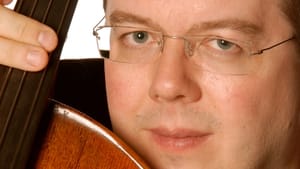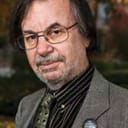Stay in the Loop
BSR publishes on a weekly schedule, with an email newsletter every Wednesday and Thursday morning. There’s no paywall, and subscribing is always free.
Ambitious and uncompromising
Emerson Quartet at the Perelman

The Emerson Quartet opened the Philadelphia Chamber Music Society’s year with a program built around the key of F. Mendelssohn’s Quartet No. 6 in F minor began the recital, with Shostakovich’s Fourteenth Quartet in F sharp rounding out the first half, and Beethoven’s First Rasoumovsky Quartet in F concluding it.
The program was ambitious and uncompromising and, at a good hour and a half of music, of a length rarely seen on either chamber or orchestral programs in this country. With its excellent new cellist, Paul Watkins, the Emerson brought off the evening with its accustomed brio but also with what seemed to this listener a warmer and more introspective sound than I’ve heard in past years.
The program itself, certainly, was built around the theme of inwardness. Mendelssohn’s quartet was his last major composition, completed in 1847 in the wake of his beloved sister Fanny’s death. Mendelssohn himself didn’t survive the year— dying, like Fanny, of a stroke that was a hereditary propensity in their family.
Mendelssohn’s farewell
No doubt the quartet, impassioned and turbulent (though even in its agitation characteristically elegant as well), reflected the composer’s grief at Fanny’s death. But it may also be read as an elegy in prospect for himself. It offers little relief from the sense of a furious onrush without issue, or from the dark shades of the F minor signature, in which all the piece’s movements but the Adagio are cast.
Mendelssohn was the quintessential figure of the first, post-Beethoven era of the Romantic movement— in which Classical lucidity was combined with a freer emotional range— and the period may be said to have passed away with him. Liszt and Wagner would soon inaugurate the mature phase of Romanticism (Berlioz was already an outlier), but Mendelssohn’s farewell statement in the F minor Quartet shows how much depth of emotion could still be expressed in traditional forms, and the twist that hurtles the music from the trio of the Scherzo into its last section was as startling as most anything you’ll find even in Liszt.
Shostakovich after Stalin
The specter of the end hovers above the Shostakovich Fourteenth as well, as it did over almost everything the composer wrote following the collapse of his health in 1966. One critic has referred to the work of this period as a “black legacy,” yet it is deeply inspiriting too.
At this point, Shostakovich was far removed from the wars of Socialist Realism, with its demand for musical banality and forced cheer; far, too, from the horrific (and terrifying) official condemnations of his work he had been forced to endure in 1936 and 1948. The mark those events had left on him was permanent, and Shostakovich was to recall them pointedly in the Adagio movement of the Fourteenth Quartet.
But this music, as in all his final quartets (11-15), exists in that timeless realm that’s also inhabited by the last five Beethoven quartets— or, more specifically in Shostakovich’s case, the borderland between life and death where the spirit soliloquizes and turns its last pirouettes.
Private music
Shostakovich’s multiple ailments had left him unable to compose for two years, and the Fourteenth Quartet, written in 1973, was his first work since the Fifteenth Symphony of 1971. It begins with a wayward, Chaplinesque tune of the sort that often opens late Shostakovich, but within a moment it leads to a rout of furious, slashing chords. Further thematic material is introduced, and the mercurial development, with its widely spaced textures, is brought to a quiet close.
The Adagio begins with a long, rhapsodic violin recitative, one of the most striking soliloquies in late Shostakovich (and, incidentally, based on a Schoenbergian tone row). This is music so private that one seems almost to be trespassing on it, and yet it is profoundly expressive too.
Eugene Drucker played it with particular insight and sensitivity. It gives way to an achingly beautiful melody for solo cello that seems— and indeed is— a reminiscence from elsewhere; it’s a transposition of the aria, Oh Seryozha, from Shostakovich’s opera Lady Macbeth of Mtsensk, the work that precipitated the first attack on the composer in 1936.
Defiant gesture
Quotation and self-quotation are a frequent device in late Shostakovich, as the composer looks back both on his work and that of his peers in the Classical tradition. But there is nothing as nakedly self-assertive as this example. It erupts as if from nowhere, and yet folds into the fabric of the Adagio, completing rather than marring it.
In a political context, it’s a defiant gesture of survival and artistic independence; but personally, it’s an affectionate salute to the work’s dedicatee, Sergei Shirinsky, the cellist of the Beethoven Quartet that premiered all but two of the Shostakovich quartets. (Seryozha is the Russian diminutive of Sergei.)
After a frenetic climax, the Adagio segues into the finale by means of plucked notes that again sound out Shirinsky’s first name. Here, too, the music runs a gamut of emotions, with phrases tossed rapidly back and forth. The “Seryozha” melody is reprised, and the music winds down toward a final silence.
The Fourteenth is rarely played, and the Emerson did it fine justice: by which I mean it played the work as well as a Western quartet can, for only Russian musicians can fully capture some of its nuances.
Beethoven’s new world
With Beethoven’s First Rasoumovsky, the evening was both on and off more familiar ground. It is of course a staple of the repertory, but heard with a sense of its historical moment it is deeply strange; for with its companion pieces of1805-06, the Eroica Symphony and the Appassionata Sonata, Beethoven revolutionized the music of the symphony, the chamber ensemble and the solo keyboard, respectively.
The examples of the Eroica, with its vast new scope, concentration and power, and of the Appassionata, with its formidable density and headlong thrust, are well known. But this first of the three Rasoumovskys transformed the string quartet no less.
The first six Beethoven quartets, grouped under Op. 18 (1800), had been on the cutting edge of the medium, but the first bars of this Seventh Quartet take us into a new sonic and psychological world. It begins with a great Beethovenian shrug and proceeds for 19 measures in C major before reaching the F major signature.
Beyond the summit
A movement of hardly less force, complexity, and length than the opening movement of the Eroica ensues, to be followed by the first Scherzo of the chamber music repertory and only the second, after that of the Eroica, that Beethoven, as the form’s inventor, had written.
The Adagio, in F minor, is wholly original in its inwardness and depth, the precursor of the great symphonic adagios of Bruckner and Mahler. A rhapsodic passage, such as Beethoven would employ again in the A minor Quartet, Op. 132, leads to the briefer but no less ingenious finale with its striking Russian theme. Mozart and Haydn aren’t being left behind here— they occupy their own empyrean— but a wholly new ground is being laid that the next two centuries will hardly fill: the First Rasoumovsky is still radically contemporary.
Had Beethoven’s career stopped here, the triad of the
Eroica,
the Appassionata and the First Rasoumovsky would be far more visible for what it is: a summit in the history of Western art. But Beethoven would go on to write six more symphonies, including the Fifth and the Ninth, and the great cycles of the late piano sonatas and quartets.
Explosive finale
The seminal importance of the First Rasoumovsky has been eclipsed in particular by the fact that it was only the first of the set of three that comprise Beethoven’s Op. 59 and, of course, by the singular prestige of the late quartets. The Emerson gave it a strong and cohesive performance and followed it by the explosive finale of Op. 59, # 3, as an encore— a coda to the evening that brought the Kimmel Center audience to its feet.
The Chamber Music Society has a rich season planned. It will be hard to top this opener, though.
What, When, Where
Emerson Quartet: Mendelssohn, Quartet No. 6 in F minor, Op. 80; Shostakovich, Quartet No.14 in F#, Op. 142; Beethoven, Quartet No. 7, Op. 59, #1. October 18, 2013 at Perelman Theater, Kimmel Center, Broad and Spruce Sts. (215) 569-8080 or www.pcmsconcerts.org.
Sign up for our newsletter
All of the week's new articles, all in one place. Sign up for the free weekly BSR newsletters, and don't miss a conversation.

 Robert Zaller
Robert Zaller